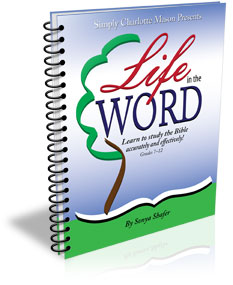Life in the Word is both a course about how to study the Bible as well as a guide for the study of selected books and topics. While it is recommended for grades 7 through 12, it is equally suited for adults who need to develop their Bible study skills. It is non-denominational and does not promote any particular doctrines, so it is useful for all Christians.
You can use any version of the Bible, and you will also need a Strong’s Concordance plus one or more Bible reference works such as commentaries or handbooks.
The guide is a workbook that walks you through various ways to tackle Bible study: book study, word study, topical study, doctrine study, narrative study, character study, and inductive study. There are eleven chapters in the book, and each chapter is further broken down into two or more lessons. Students should be able to complete one lesson per day (or class session) although you might find that some students need more time for some lessons.
Each chapter begins with an explanation of the method or else a brief summary of the method if this is a second application of a particular method. Some of the lessons provide a few examples of how to write responses, but most lessons expect that students can easily figure out what they should write. Shortcuts are provided for some studies. For example, for a character study on Paul in chapter 7, Shafer has already looked up in Strong’s Concordance the locations in the Bible where Paul is mentioned. She has written those scripture references on blank lines with space for the student to record what he or she discovers about Paul in each. Later in the book, chapter 11 has students complete a character study on Titus, but this time students need to identify the passages for themselves before they can write what they find about Titus.
This approach of providing a little more help and guidance for the initial lesson and less for a follow up lesson on the same type of study is also used for book studies, topical studies, and narrative studies. Words study, doctrine study, and inductive study are each covered in a single lesson. The inductive study chapter is not as detailed and prescriptive as in guides that teach only inductive study, but it does provide students with the key techniques they should use.
Life in the Word has relatively brief teaching information. Shafer makes the lessons simple and direct. The book consists primarily of lined or formatted pages for completing each study.
I very much like this approach since it teaches not only one, but many approaches to Bible study. Life in the Word gives students an opportunity to work with each approach, laying the groundwork for more intensive Bible study in the future.
The print edition has a plastic spiral binding so that it lies flat while you write in it. It is also available as a downloadable PDF. A very sizable free sample is downloadable at the publisher’s website, so you can actually try it before buying.








